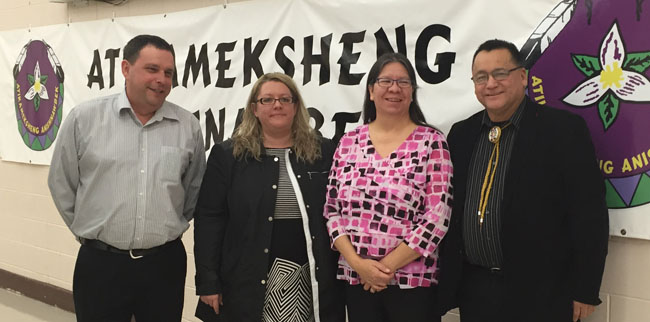E-medical records opens new era in First Nations health care in Northern Ontario

By Laura E. Young
NAUGHTON, Ont. – Health care for the 14 First Nations is entering the electronic age with the ultimate goal of enhanced and better access to health information for the member communities along Lake Huron and Manitoulin Island.
Giiwednong Health Link (GHL) and Nightingale Informatix Corporation, which delivers cloud-based electronic health records (EHR), celebrated the launch of the GHL Electronic Medical Record project and the GHL digital health program on Thursday, Dec. 3.
“The GHL digital health program represents a major step forward in enhancing health services delivery to improve First Nations health outcomes and to ensure they are on par with provincial and national outcomes,” says Patrick Madahbee, Grand Council Chief and chair of the Ontario Chiefs Committee on Health.
As well, seven new, full time, permanent jobs across the North will be created as a direct spin-off of the project. Postings are expected to be available before the end of 2015, says Pam Corbiere-Naponse, digital health program manager Giiwednong Health Link based at Atikameksheng Anishnawbek in Naughton, just west of Sudbury.
The project has been in the works since 2007 through the efforts of the 14 member nations of the Giiwednong Health Link, along with Health Canada and the province of Ontario. The project has received $5 million in funding from Health Canada.
There is a definite need to provide more efficient health care to the communities, in terms of data sharing and access to programs and services in First Nations communities, says Naponse-Corbiere.
Currently, EMRs are available in Aboriginal health centres with the resident doctors and nurse practitioners, she says.
But in many cases there is not a consistent linkage or a complete health picture available. With the EMR project, all the programs can start working together, essentially speaking to one another.
“Like our Healthy Babies, Healthy Children, our community programs need to talk to the EMRs so that primary care providers can provide referrals and see the big picture of a client or family.
“Information is knowledge and knowledge is power. We as First Nations people, our communities don’t have that kind of information right now.”
Having that information at hand, however, will make it easier to present their case for further Health Canada funding as they will have exact statistics to reflect their growing needs, she adds.
“Now we can say, ‘Look, I have 25 clients that don’t have access to mental health services and I have exact statistics to prove that.’ It’s all these growing needs (as to) why the EMRs and the digital health world is going to benefit our community.
By the end of March, Wikwimekong Unceded Indian Reserve will be the first community to start operating Nightingale Informatix’s EMR technology.
The program includes vital staff training and support, says Naponse-Corbiere. “There are still a lot of paper charts out there. How do we change that thinking that electronic medical records are coming?”
The remaining centres are expected to be operational by March 2017.

